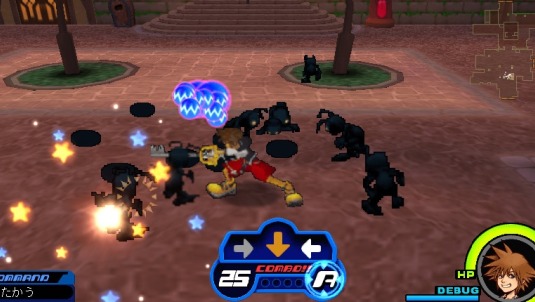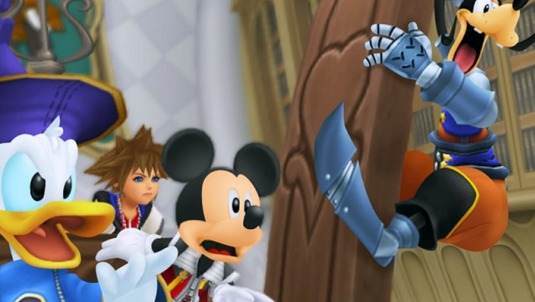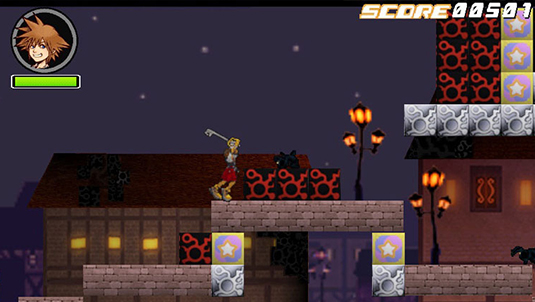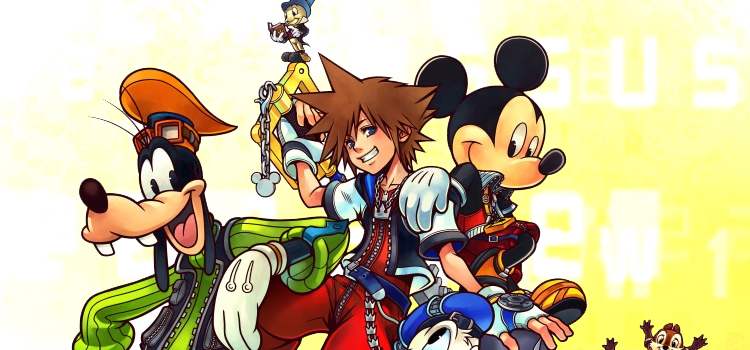“Sora, this was the day that your journey began. I know, because I was here, too. It’s time for the truth.”
Kingdom Hearts Re:coded finds its origins in Kingdom Hearts coded, a cell phone game that was announced at the 2007 Tokyo Game Show alongside Kingdom Hearts Birth by Sleep and Kingdom Hearts 358/2 Days. All three games–a prequel, a midquel, and a sequel–ended up lending themselves to the continuation of the Kingdom Hearts franchise, but only Kingdom Hearts coded took place after the events of Kingdom Hearts II. But for a story that could potentially reveal the future of Kingdom Hearts, the game was rather limited, both in reach and in content: it was played across eight downloadable episodes made available over time (nine if you include the pre-install episode, which was released before the game itself), and it was only playable on Japanese cell phones. Fortunately, Square Enix decided to re-make Kingdom Hearts coded from the ground up, releasing it as Kingdom Hearts Re:coded for the Nintendo DS. This version of the game would later be released in territories outside of Japan.
But for all of its significance, and all of the hard work that went into producing it, Re:coded has only received mixed reviews from critics and fans alike. Calling it skip-worthy, frustrating, and tepid, many critics and Kingdom Hearts fans have decided to label Re:coded as the “black sheep” of the Kingdom Hearts family. What’s wrong with the game? Why isn’t it praised almost universally, like Birth by Sleep? How could a sequel in a linear narrative be skippable? More importantly, is it possible that these fans and reviewers might be mistaken? On this day, which also happens to be my birthday, I will present an analysis of Kingdom Hearts Re:coded, its general reception, and why the game is perhaps better than you thought it was.
 Since Kingdom Hearts Re:coded is a game first and a narrative second, let’s start with the gameplay. Like all of the Kingdom Hearts games, Re:coded is an action RPG that takes place across various levels (known as “worlds”) lifted directly from Disney films. The game sticks to the tried-and-true formula of the franchise, but that’s one element that fans might not appreciate. At this point in the franchise’s history, “rehashing” the first game has already become notorious. Kingdom Hearts Chain of Memories features worlds from the first game (although with a different twist), and Kingdom Hearts 358/2 Days repeats this concept (although it also expands the previous worlds and bridges the games by chronicling changes in those worlds). As a fan of Re:coded, even I have to admit that playing through the same worlds for the fourth time or so isn’t exactly a thrilling idea. But if you haven’t noticed, none of these games offer a simple rinse-and-repeat; there’s always a caveat, and the same holds true in Re:coded.
Since Kingdom Hearts Re:coded is a game first and a narrative second, let’s start with the gameplay. Like all of the Kingdom Hearts games, Re:coded is an action RPG that takes place across various levels (known as “worlds”) lifted directly from Disney films. The game sticks to the tried-and-true formula of the franchise, but that’s one element that fans might not appreciate. At this point in the franchise’s history, “rehashing” the first game has already become notorious. Kingdom Hearts Chain of Memories features worlds from the first game (although with a different twist), and Kingdom Hearts 358/2 Days repeats this concept (although it also expands the previous worlds and bridges the games by chronicling changes in those worlds). As a fan of Re:coded, even I have to admit that playing through the same worlds for the fourth time or so isn’t exactly a thrilling idea. But if you haven’t noticed, none of these games offer a simple rinse-and-repeat; there’s always a caveat, and the same holds true in Re:coded.
THE GAME ALSO CHANGES THE BASIC KINGDOM HEARTS FORMULA OUTSIDE OF LEVEL DESIGN
Re:coded looks like another rehash, but it shakes things up more than it provides familiarity. This earthquake of game design is mostly apparent in the climax of each world’s story, in which the action RPG quite literally transforms into a different genre of game each time. Traverse Town becomes a side-scroller, offering a Mario-esque adventure as you battle the Guard Armor. Wonderland shifts into a Cabal shooter, much in the style of Sin and Punishment for the Nintendo 64; the player controls Sora as he runs forward, dodging obstacles and fighting the Trickmaster along the way. Olympus Coliseum takes the game to its roots as we explore the levels of the coliseum with traditional, turn-based, Final Fantasy JRPG flair (with Hercules and Cloud as party members). I loved these changes and I grew more excited with every new world, eager to discover what the game would turn into next.
The game also changes the basic Kingdom Hearts formula outside of level design. As Re:coded takes place in digitized versions of the Disney worlds (made out of data from Jiminy’s journal), the game introduces “debugging” mode, in which Data-Sora (a digital copy of the real Sora) fixes problems in the worlds by removing blocks and destroying Heartless. The debugging stages provide new challenges, various rewards depending on difficulty, and strongly reinforce the idea that Re:coded largely takes place in a digital world. Re:coded makes the player feel like a hacker, which is particularly evident in the game’s character development system. The player can tweak Data-Sora’s enhancements and battle commands in a similar fashion to 358/2’s panel system, while also allowing the player to change the difficulty of the game (as well as the rate of dropped items, etc.) at will. The battle system, meanwhile, takes a hint from Birth by Sleep by implementing a rolling command menu, while the game’s dialogue is a mix between traditional cutscenes and voiceless text sequences animated similarly to scenes from The World Ends with You (another Square Enix game for the Nintendo DS). Minigames, platforming, trophies, and speed challenges are all to be found in Kingdom Hearts Re:coded, which I feel stands as the most dynamic game in the Kingdom Hearts series.
 Many fans and critics target Re:coded’s story as the weakest in the entire Kingdom Hearts franchise. Because the game takes place in data versions of the Disney worlds explored in earlier games, and features data versions of Sora and Riku (the latter being a manifestation of the journal’s uncorrupted data), gamers write off Re:coded as insignificant because nothing that happens in the game seems to matter. The truth, of course, is a bit more complex than that. In regards to the franchise as a whole, Re:coded’s secret ending leads directly into Dream Drop Distance, but the game also paves the way for the eventual Kingdom Hearts III. Essentially, the real Pete and Maleficent return in Re:coded in an attempt to take over the datascape. Their ambition is referenced in Dream Drop Distance, in which Maleficent holds Queen Minnie hostage in an attempt to get King Mickey to surrender the datascape to her. Clearly, Maleficent feels that the worlds in the datascape can help her conquer the real worlds, and some fans speculate that this struggle over the datascape will become a plot point in Kingdom Hearts III.
Many fans and critics target Re:coded’s story as the weakest in the entire Kingdom Hearts franchise. Because the game takes place in data versions of the Disney worlds explored in earlier games, and features data versions of Sora and Riku (the latter being a manifestation of the journal’s uncorrupted data), gamers write off Re:coded as insignificant because nothing that happens in the game seems to matter. The truth, of course, is a bit more complex than that. In regards to the franchise as a whole, Re:coded’s secret ending leads directly into Dream Drop Distance, but the game also paves the way for the eventual Kingdom Hearts III. Essentially, the real Pete and Maleficent return in Re:coded in an attempt to take over the datascape. Their ambition is referenced in Dream Drop Distance, in which Maleficent holds Queen Minnie hostage in an attempt to get King Mickey to surrender the datascape to her. Clearly, Maleficent feels that the worlds in the datascape can help her conquer the real worlds, and some fans speculate that this struggle over the datascape will become a plot point in Kingdom Hearts III.
RE:CODED’S SECRET ENDING LEADS DIRECTLY INTO DREAM DROP DISTANCE, BUT THE GAME ALSO PAVES THE WAY FOR THE EVENTUAL KINGDOM HEARTS III
In addition to pointing out what lies ahead, Re:coded also picks up the wayward pieces from past Kingdom Hearts games. Such plot elements include Sora’s Heartless, the relationship between Sora and Roxas, Sora’s promise to Naminé, the fates of Axel and Xion, and the message in a bottle at the end of Kingdom Hearts II (which tells the story of Ventus, Terra, and Aqua from Birth by Sleep). It’s also my opinion that both coded and Re:coded were originally going to elaborate on Riku’s side of the story during the first Kingdom Hearts game, as well as King Mickey’s adventure during the same time. Unfortunately, we only get about two cutscenes hinting at these hidden stories in the final game. Overall, though, Re:coded succeeds in making the past matter.
Thematically, Re:coded expands upon earlier motifs found in the Kingdom Hearts series while simultaneously foreshadowing future developments. Memories were significant ever since the first game, although Chain of Memories was the title that cemented the importance of memories in the Kingdom Hearts series. The pain of forgetting one’s friends is revisited in Re:coded, as are the hidden memories from Sora’s youth regarding the trio from Birth by Sleep. Another motif of the series, ever since Kingdom Hearts II, has been the concept of digitized worlds and data. Featuring a digital Twilight Town (in addition to the real Twilight Town) and the Tron world known as “Space Paranoids,” Kingdom Hearts II allowed for Re:coded to explore the relationship between data and reality (quite literally, as Donald, Goofy, and King Mickey quickly discover that they themselves have been transported into the datascape without realizing it).
 By thanking Data-Naminé, Data-Sora fulfills the real Sora’s promise to the real Naminé; meanwhile, Data-Riku’s corruption and Data-Sora’s memories in relation to the memories of the datascape provide a unique insight into the nature of the self and memories, since the datascape is a digitized version of the journal (meaning, the datascape consists of digital memories). Data-Sora also obtains his very own Keyblade (as opposed to a digital copy of the real Sora’s Keyblade), hinting at what is revealed at the end of Dream Drop Distance: anything can grow a heart. Finally, when a digital version of Castle Oblivion shows up at the end of the game, things become complicated in the most intriguing of ways. The worlds of Castle Oblivion are essentially worlds-within-a-world, a status that becomes more convoluted when taken into consideration that Re:coded takes place in a digitized landscape of a journal full of memories itself. Essentially, the player explores a digital memory’s memory of digital memories (got that?). It’s a good thing we don’t explore Tron’s world in Re:coded; otherwise, I think my head just might explode. Although Data-Sora does have to debug Data-Riku at one point…
By thanking Data-Naminé, Data-Sora fulfills the real Sora’s promise to the real Naminé; meanwhile, Data-Riku’s corruption and Data-Sora’s memories in relation to the memories of the datascape provide a unique insight into the nature of the self and memories, since the datascape is a digitized version of the journal (meaning, the datascape consists of digital memories). Data-Sora also obtains his very own Keyblade (as opposed to a digital copy of the real Sora’s Keyblade), hinting at what is revealed at the end of Dream Drop Distance: anything can grow a heart. Finally, when a digital version of Castle Oblivion shows up at the end of the game, things become complicated in the most intriguing of ways. The worlds of Castle Oblivion are essentially worlds-within-a-world, a status that becomes more convoluted when taken into consideration that Re:coded takes place in a digitized landscape of a journal full of memories itself. Essentially, the player explores a digital memory’s memory of digital memories (got that?). It’s a good thing we don’t explore Tron’s world in Re:coded; otherwise, I think my head just might explode. Although Data-Sora does have to debug Data-Riku at one point…
I enjoy the complexity of Re:coded, but other gamers probably dislike the convoluted nature of the game (and the series as a whole). Kingdom Hearts is a series rife with memories of worlds, data worlds, data of memories of worlds, replicas of the original characters, Nobodies of the original characters, data versions of the original characters, Heartless and Nobody and past-self versions of villains who change their names to other characters’ names… basically, it gets complicated, and maybe not a lot of people have the patience for it. Re:coded on its own isn’t that difficult to understand, but in the greater Kingdom Hearts landscape, it might represent a fault of the series for some fans and critics. I, however, stand in firm defense of Kingdom Hearts Re:coded, and everything that it represents.
What do you think about Re:coded? Is it your least favorite game in the series, or perhaps you actually like it? Share your thoughts in the comment section below. Just remember one thing:

Recent Comments